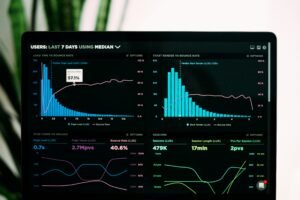“How has an AI tool improved your ability to segment and understand your customer base? What’s one surprising insight you gained?”
Here is what 13 thought leaders had to say.
Jasper Pricing and Support Impress Marketing Team
We’ve been using Jasper for several marketing tasks for the past few years, and we’ve consistently been impressed with their pricing and customer support. They also keep adding new features–like market segmentation. We were primarily using them for content generation before. One of the big insights we gained was that, when we’re targeting small, local businesses, we’re really targeting those business owners, and focusing on their demographics can be effective.
Jonathan Palley, CEO, QR Codes Unlimited
AI Reveals Influential Advocates Among Occasional Users
Using an AI tool has significantly enhanced my ability to segment and understand our customer base by allowing us to move beyond basic demographic data and dig into behavioral and psychographic patterns. The AI analyzes customer interactions, purchase history, content engagement, and even sentiment in feedback, helping us create much more nuanced and actionable segments.
One surprising insight we gained was that a group we initially labeled as “occasional users” — who we assumed were less engaged — were actually highly influential advocates. They weren’t using the platform frequently themselves, but they were consistently referring others and sharing our tools in professional forums. That changed how we approached them entirely; instead of trying to convert them into heavy users, we focused on empowering them as brand ambassadors.
Daria Turanska, Legal Manager, Faster Draft
AI Uncovers Hidden Customer Groups for All Brands
AI tools have made it much easier to analyze the different types of customers a brand has by sorting through large amounts of data quickly and spotting patterns that might not be obvious otherwise. These tools help you group people based on what they like, how they shop, and when they interact with your brand. One unexpected insight I’ve discovered using AI is that there are often smaller, unique groups of customers within your audience who behave differently than the rest. For instance, I found a group of shoppers who only buy during certain times of day or respond better to specific kinds of messages—something I probably wouldn’t have noticed without AI. This level of detail allows you to personalize your marketing, plan inventory more accurately, and form stronger connections with your customers. In short, AI helps turn complicated data into clear, useful strategies for reaching the right people in the right way. Before AI, this type of analysis would have taken long hours or could only have been conducted by an analytics professional. Now, brands of all sizes can gain a deep understanding of the customer base and opportunities that exist with readily available AI tools, even without a paid subscription. It’s a game-changer for democratizing insights and leveling the playing field for brands and companies.
Jenica Oliver, CMO, blueprint marketing group, llc
AI Detects Loyal Customers Before High Spending Begins
AI tools can improve customer segmentation by analyzing behavioral and transactional data at a level that’s hard to match manually—spotting micro-segments based on patterns like purchase timing, engagement frequency, or response to specific offers.
One surprising insight these tools often reveal is that high-value customers don’t always have the highest spend upfront—many start with smaller, consistent purchases but show strong retention signals early. Recognizing this can shift marketing from chasing only big initial spenders to nurturing these “slow burn” loyal customers who drive long-term revenue.
Vipul Mehta, Co-Founder & CTO, WeblineGlobal
——————————————-
AI Challenges Assumptions, Reveals Unexpected Market Opportunities
One of the biggest leaps we’ve made with AI is in segmenting and truly understanding our target markets — not just customers, but also investors, partners, and even potential scientific collaborators. We built internal tools that process massive volumes of scientific publications, patent filings, and market reports, then layer that with behavioral and transactional data to form nuanced segments.
The surprising insight? The “obvious” market is almost never the most valuable one. In one case, while analyzing potential applications for a biomedical innovation, AI surfaced an entirely different industry — advanced materials manufacturing — as a more lucrative and faster-to-adopt entry point. Without that AI-driven cross-domain pattern detection, we would have missed a multi-million-dollar opportunity.
For me, the real power of AI in segmentation is that it doesn’t just confirm your assumptions — it challenges them, and that’s where the competitive advantage lies.
Igor Trunov, CEO, Atlantix
——————————————-
Waxing Company Discovers Customers Seek Skill Mastery
We used AI to analyze thousands of customer reviews, and it completely changed how we see our audience. We assumed our customers were segmented by skin type or their previous hair removal methods. The AI showed us the most important segmentation was actually based on user confidence.
The surprising insight was that our most loyal customers weren’t just buying a waxing kit. They were buying the feeling of successfully mastering a new skill. The praise in our best reviews wasn’t just about the product’s results, but about how our clear instructions and design made them feel capable and proud. We learned we aren’t just in the hair removal business. We’re in the self-efficacy business. This has refocused our entire strategy on creating an empowering, foolproof user experience.
Dan McElwee, Head of Retail, Tress Wellness
AI Segmentation Transforms Credit Risk Assessment Strategy
We used an AI-powered segmentation tool that went beyond the usual demographics and spending categories. It analyzed transaction patterns, repayment behavior, digital engagement, and even call center sentiment data to create behavioral clusters.
The surprising insight? The customers who appeared “high risk” on traditional credit metrics weren’t always the most likely to default. One specific cluster younger customers with moderate credit scores had occasional late payments but were extremely responsive to personalized payment reminders sent via mobile push notifications. They had a much higher cure rate compared to another group with the same credit score who rarely used digital channels.
That shifted our collections approach: we prioritized digital-first outreach for these “mobile-engaged strugglers” and focused call-center resources on the “digitally silent” group, which was harder to reach and more likely to need structured repayment plans.
The end result was better allocation of resources, higher repayment rates, and fewer wasted contact attempts all because the AI segmented customers based on behavior, not just their credit file.
SAI KIRAN NANDIPATI, Solution Architect, EY
AI Surfaces Value in Seemingly Inactive Customer Segments
When I advise global e-commerce teams or guide ECDMA members, one of the most persistent challenges is moving beyond superficial customer segmentation. Many organizations rely on broad demographic buckets or basic behavioral triggers, which often miss the nuanced realities of how people shop and interact with brands. The introduction of AI-driven segmentation tools has meaningfully changed my approach in both consulting and operational leadership roles.
One particular AI solution made a substantial difference for a client in the specialty retail sector. They had a mature CRM, yet customer engagement was plateauing. By integrating an AI tool that ingested transactional, behavioral, and third-party data, we built dynamic segments that continuously evolved as new data streamed in. Instead of grouping customers by age or region, the AI surfaced clusters based on shared product affinities, purchase cadence shifts, and even subtle changes in browsing patterns.
The most surprising insight from this project was the discovery of a sizable segment that I would have previously classified as “inactives.” The AI revealed that, although these customers had not made a purchase in the past six months, they were highly engaged with content – reading buying guides, saving products, and interacting with community forums. Traditional RFM recency, frequency, monetary models would have deprioritized them. With this knowledge, we launched a tailored content-driven campaign instead of a discount-heavy win-back offer. Engagement rates climbed, and a significant portion converted within weeks, underscoring how AI can surface high-value opportunities that standard methods overlook.
What I have learned – and often share with business leaders – is that AI segmentation is not about replacing human judgment but about surfacing patterns that would take a team months to recognize, if at all. The key is to operationalize insights quickly: once AI highlights an unexpected segment or behavior, activate test campaigns and measure results in real time. This cycle of discovery and execution has become central to how I help organizations drive growth and deepen customer understanding.
Eugene Mischenko, President, E-Commerce & Digital Marketing Association
AI Identifies Hidden High-Value Customers Among Casual Buyers
Using an AI tool has drastically improved my ability to segment and understand my customer base. I now rely on machine learning algorithms that analyze purchase behavior and engagement patterns, allowing me to create highly targeted segments. One surprising insight I gained was discovering that a significant portion of my customers—who I initially thought were just casual buyers—actually had high lifetime value due to their consistent purchasing habits. The AI tool helped identify this group by analyzing smaller but more frequent transactions, which would have been overlooked manually. This insight shifted my marketing strategy, allowing me to tailor messaging and offers specifically for this valuable group. Overall, the tool has given me a much clearer picture of who my customers are and how they interact with my brand, making my campaigns more efficient and personalized.
Nikita Sherbina, Co-Founder & CEO, AIScreen
AI Reveals Engaged Non-Buyers, Boosts Conversion Rates
Employing AI technologies such as customer segmentation tools has completely transformed the way we engage and react with customer targets. For example, customer segmentation tools utilize AI to move beyond basic demographic segmentation by using data to consider a customer’s behavioral patterns and predictive modeling. We have used AI to analyze customer journeys by use of this segmentation model and then use the insights to develop micro-segments based on how our customers browse and select products, or what they like and engage with amid this engagement to other marketing opportunities. This process ironically resulted in a clearer picture and real-time understanding of customer targets.
One unexpected realization we had was that we were able to identify a very engaged user group that had never purchased but were consuming our blog and social channels consistently; they had demonstrated an interest in our product, but we clearly were not marketing to them with the appropriate message. Our AI tool identified this user group’s interest patterns which allowed us to run a content-driven campaign that established trust and provided value, prior to asking for a purchase, thus resulting in a 30% increase in conversions from this group of users we were not nurturing.
Gianluca Ferruggia, General Manager, DesignRush
AI Analytics Uncover Patterns Traditional Methods Miss
AI tools have significantly improved customer segmentation through advanced data analytics and predictive modeling. By utilizing machine learning, these tools can swiftly analyze vast datasets to uncover patterns that traditional methods might miss. This allows businesses to create nuanced segments based on behavior and preferences, rather than just demographics. Understanding varied customer responses enables tailored outreach, enhancing engagement and conversion rates.
Mohammed Kamal, Business Development Manager, Olavivo
HubSpot AI Exposes Unexpected High-Value Customer Segment
I use an AI driven analytics tool – HubSpot’s predictive lead scoring and segmentation – and it has completely changed how I view my customer base. Before I relied heavily on basic demographic filters and gut instinct to group customers, but the AI looks at behavioral data, purchase history and engagement patterns in ways I couldn’t see on my own.
One of the biggest surprises was that some of my highest value repeat customers didn’t fit the profile I always assumed. I used to target heavily towards younger, tech savvy buyers but the AI identified a 40-55 year old segment that not only purchased more frequently but also had a higher average order value. They weren’t as active on social media so I would have overlooked them in my old marketing approach but they engaged deeply with email campaigns and loyalty programs.
That discovery led me to create targeted offers and messaging for this group and it increased retention and revenue without increasing ad spend. It was a good reminder that sometimes the most profitable customers aren’t the most visible ones – and that AI can spot hidden patterns way earlier than manual analysis ever could.
Sovic Chakrabarti, Director, Icy Tales
AI Discovers Weekend Browsers Become Weekday Buyers
AI tools have transformed how we slice and dice customer data. Instead of broad groups, we get precise segments based on behavior, preferences, and even subtle signals like browsing time. This clarity helps tailor campaigns that actually hit the mark.
One surprise? AI revealed a segment of customers who interact mostly on weekends but convert during weekdays. We never spotted this pattern before, so adjusting timing boosted sales noticeably.
Another insight was uncovering overlooked micro-groups with high engagement but low purchase rates. This nudged us to test new offers and messaging, turning fence-sitters into buyers.
AI does the heavy lifting on data crunching, freeing us to focus on strategy. It’s like having a detective who spots clues humans might miss. In marketing, that kind of edge makes all the difference.
Nick Mikhalenkov, SEO Manager, Nine Peaks Media




